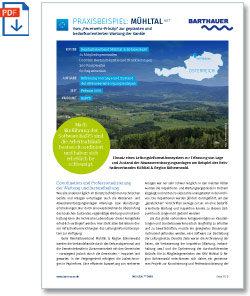From the “fire fighting principle” to planned and demand-driven sewer maintenance
Using a pipeline management system for the collection of location and condition data of the wastewater disposal facilities using Reinhalteverband Mühltal & Region Böhmerwald as an example.
Client
• Reinhalteverband Mühltal & Region Böhmerwald
• 24 member municipalities
• 1,000 km of existing sewers and force mains
• 300 pumping stations
• 60 rainwater basins
Task
• Data collection on the location and condition of wastewater disposal facilities
Product
• BaSYS
Project start
• February 2010
Coordination and professionalisation of maintenance and upkeep
Like all other technical equipment and facilities, water supply and wastewater disposal facilities are also subject to signs of wear and ageing. Only through the recurring inspection of the structural condition, regular maintenance and upkeep can the technical service life of the wastewater disposal facilities be significantly extended. This is where the pipeline management system is available to all operators of these infrastructure facilities.
At the Reinhalteverband Mühltal & Region Böhmerwald, the collective sewers are inspected and maintained by board personnel and the municipal sewers in cooperation with the municipalities – but mainly by the municipalities. Records were kept in paper form in the past. The efficient analysis of multiple facilities was extremely challenging. In most cases the inspection and maintenance results were filed in folders and then remained untouched in the archives for many years. The inspections were carried out annually to meet the “legal” regulations. Demand-driven maintenance and inspection could not even be considered at the time!
But to maintain and manage the large portfolio of sewer lines and special structures over the long term, a suitable controlling tool had to be found, a software product for representing the distribution networks. Data archiving, improving the inspections (maintenance, upkeep etc.) and optimising the required processes were the main goals. The 24 member municipalities of RHV Mühltal & Region Böhmerwald therefore decided to implement a joint project for the coordination and professionalisation of maintenance for its wastewater disposal facilities. Existing sewers and force mains with a total length of more than 1,000 km, approximately 300 pumping stations and 60 rainwater basins had to be recorded, maintained and inspected.
Uniform representation and administration of sewer networks and special structures in the pipeline management system
The heart of the entire project was a pipeline management system prepared by the member municipalities based on specifications established by the member municipalities and subsequently maintained by the board. A new classification system for this had already been introduced and the population of the databases (field assignment, libraries etc.) was specified by the board. In cooperation with the municipalities, all sewer networks and special structures will be represented and administered jointly in the pipeline management system in the future. The quality and quantity of inspection and maintenance was improved several times over by converting to digital records of all inspection and maintenance data.
The BaSYS software developed by BARTHAUER was used to implement the project. As a pipeline management system, is supports all process steps for the planning, administration, operation and updating of supply and disposal networks: From the collection of technical data to their specialised review, classification, calculation, planning and optimisation to rehabilitation. The graphical, interactive review and output of the data is possible in many different forms, both in all leading GIS/CAD systems and through web solutions.
After introducing the BaSYS software developed by BARTHAUER, the coordination of workflows has been optimised and they run much faster. All tasks related to maintenance, rehabilitation and upkeep are digitally documented and traceable at any time. Planned and demand-driven maintenance has replaced the “fire fighting principle”. The condition of the facilities is fully known at all times!
User benefits
Pipeline management system as an information medium
- Overview of the entire water supply and wastewater disposal system at the push of a button
- Visual representation of diverse information for the own distribution network
- Querying, filtering and reading a wide range of information according to various criteria
- Digital representation
- Faster access to network data
Pipeline management system for facility maintenance
- Efficient completion and documentation of maintenance work on the facilities
- Input and reconciliation of the maintenance results directly in the pipeline management system
- Stored data can be accessed in real time
- Current system documentation as the basis for future network planning and reinvestments to maintain the distribution network
Conclusion
- Time savings and facilitation of work
- Current network data and data security at all times

